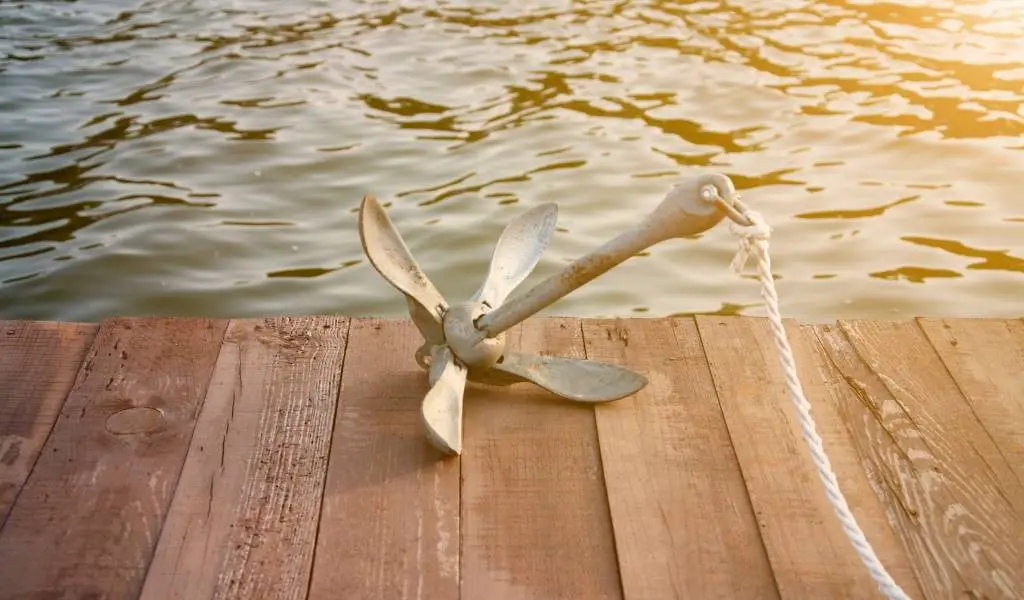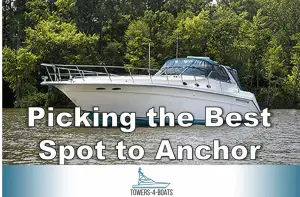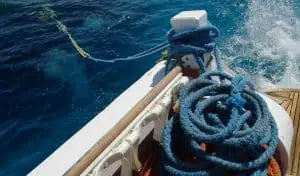Pontoon boats are one of the most popular boats today. You can take them on leisurely cruises, fishing, or an afternoon of water skiing and wakeboarding with your family. They also offer plenty of room for your extended family and friends for a day of fun in the sun. Their greater size makes them a little more challenging to anchor than a fishing or ski boat. Their high profile catches the wind, which puts a greater demand on your anchor.
Your anchor is one of the most important pieces of equipment on your boat. If you have a large pontoon boat, you definitely want to be certain you’ve got the best anchor for your boat. When I was researching which anchor to buy for my pontoon boat, I wanted to know which of these is best for anchoring a pontoon.
There are essentially four kinds of pontoon anchors that are used today:
- Box anchors
- Fluke anchors
- Grapnel anchors
- Plow anchors
Box anchors are the overwhelming preferred choice. But they don’t work well in every situation. Grapnel anchors are the second favorite among pontoon owners, and the fluke anchor comes in at number three. Regardless of what everyone else uses, it’s important to remember the best anchor for your pontoon boat depends very much on the type of water you cruise in.
Important Factors to Consider
When you’re deciding which anchor to buy for your pontoon boat, you want to be certain you find one that’s right for your boat and how you use it. Remember, there is no one-size-fits all anchor. What works best for your buddy who takes his boat on a lake with a sandy bottom, won’t work very well on the rocky bottom where you go boating.
Before you buy an anchor, you should do your homework. Here are the key factors you need to consider:
Pontoon Boat Factors
- The weight of your pontoon boat
- The length of your craft
Water Related Factors
- Type of water bottom
- Prevailing wind speed
- Currents or tides
If you want more information about anchoring a boat in wind, check out my recent article.
Best Anchors for Pontoon Boats
Here are the best anchors for pontoon boats:
1. Box Anchor: Seachoice Fold-and-Hold Anchor
Tip: The Box anchor is best for muddy and grassy/vegetated bottoms
The box anchor is probably the best all-around anchor for pontoon boats because it performs well where pontoon boats are most often used – in rivers and lakes. Most rivers and lakes have bottoms that are either muddy covered with vegetation. The box anchor holds very well under each type of condition. It’s also easy to set – you drop it over the side and it sinks into the mud.
The box anchor holds well in mud because it sinks into the bottom, usually 1 to 2 feet depending on the weight of the anchor and the density of the sediments. Usually, 25 pounds is adequate for getting enough penetration into the bottom material. The sides of the square anchor provide a lot of surface area which creates friction with the mud it contacts. This friction provides the excellent holding power of the box anchor.
Bottoms covered with grass and other vegetation are a challenge for penetrating anchors such as the mushroom anchor because their roots don’t allow the anchor to sink into the bottom. The box anchor has several pointed flukes that can penetrate into the roots and get a solid grip.
In rocky conditions, the flukes can hook onto a rock or crevice and keep your pontoon boat from drifting away. It can be difficult to free the box anchor if you’re pulling it by hand. All you need to do to free it up is pull your boat forward and most of the time the anchor will come free.
The box anchor can be a challenge with sandy bottoms. The problem I find is that the flukes don’t penetrate as deeply as other types of anchors do because of their configuration, and the boat can come loose if there is much wind or current. On a calm day, this doesn’t matter. If you want some additional information on this topic, I prepared an article on how to pick the best spot to anchor.
One drawback to box anchors is their cost – they are usually the most expensive option for a pontoon boat. Given their solid performance under varying conditions, I find this anchor to be well worth the extra money. It’s also worth paying a little extra for an anchor that folds flat so it doesn’t take up a lot of room on your boat.
Fluke Anchor: Seachoice Deluxe Anchor
Tip: The fluke anchor works best in sand or gravel bottoms
Fluke anchors work by having the pointed flukes dig into the bottom where they grab hold of the sand or gravel. This method of gripping the bottom means that the anchor does not have to be heavy. In calm conditions, a 15-pound anchor can usually hold a 30-foot pontoon boat. This is a huge benefit if you’re the one who has to hoist the anchor up.
The main factor to consider with the fluke anchor is the size. Weight is only a minor factor with these anchors. Bottom conditions determine what weight you need. In mud, a light anchor can easily penetrate the bottom and get a good hold. In sand, you’ll want to go up one size to ensure the anchor digs in properly. You may have to back your boat up a little bit to get the anchor to set. Once it does, it’s very dependable and won’t usually come loose.
The sharp flukes can damage your pontoon boat. For this reason, you’ll want to be able to secure it to protect your boat. I suggest either a storage bin beneath the seats or a padded storage bag.
The fluke anchor can come loose if the wind direction shifts or the tide changes.
Grapnel Anchor: Seachoice Folding Grapnel Anchor
Tip: The grapnel anchor works best with rocky bottoms
Rocky bottoms call for specific anchors and the Grapnel Anchor really shines in these conditions. A typical grapnel anchor has at least 4 large arms which allow it to get a firm hold on most sizes of rocks.
You’ll have to set the anchor by dropping it onto the bottom and then drifting or backing up a few feet to allow its arms to find a hold on a rock. Once you set this anchor, it provides the most secure hold on a rocky bottom compared to any other anchor.
The grapnel anchor is generally the lowest cost option, and many boat owners use them as a second anchor. Two anchors are especially good if you’re in a strong current or high winds.
A key benefit of the grapnel anchor is its small size. A folding anchor can fit into a small space under a seat or in a cubby. The primary downside to grapnel anchors is they can be more difficult to free up than some other styles.
Plow Anchor: Seachoice Plow Anchor
Tip: The plow anchor performs well in sand or gravel
Plow anchors, also known as digger anchors, consist of perpendicular flukes that are designed to dig into the bottom. They are similar to the fluke anchor, except the flukes can adjust to different angles. This feature helps the plow anchor set much faster.
The plow anchor’s flukes grip very well in mud, sand, or vegetation. They don’t perform as well in rocky conditions, especially if you have a large pontoon boat.
Anchor Properties to Think About
The Weight
For an average sized pontoon boat, your anchor should weigh between 15 and 20 pounds. The box anchor is available in larger sizes than the other three anchors, and it usually the heaviest. In most cases the heavier the anchor the better. But, don’t overdo it just because you own a pontoon boat. It’s unlikely you’ll need an anchor that’s 30 pounds. Any more weight and you’re working harder than you need to.
This table is a good general guide for the size of anchor required based on your boat’s length.
| Pontoon Boat Length | Anchor Weight |
| 20 feet or less | 12 – 15lbs |
| 20 – 30 feet | 20 – 30lbs |
Material of Construction
Pontoon boat anchors come in a variety of materials. They are constructed of stainless steel, aluminum, vinyl-coated steel, and galvanized steel. Any of these will materials will provide you years of service.
Stainless steel and aluminum are both corrosion resistant. They are also very expensive materials.
Many anchors are made of conventional steel that is coated with a polymer such as vinyl or epoxy. They are usually the cheapest option. However, these coatings can be damaged which allows the mild steel to corrode.
My anchor is made of galvanized steel. I determined that a galvanized anchor provides the best balance between corrosion resistance and price. It’s not as attractive as similar anchors made of aluminum or stainless steel, but I keep mine stowed under a seat and it’s only visible when I’m setting it or hauling it back onboard.
Rope and Chain
The rope (or the rope and chain) is part of your anchor system. Check to confirm that the anchor you’re purchasing includes a rope or chain. Not all do.
Your anchor’s rope should be sturdy and strong enough for your boat. That last thing you want is for a strong wind or current to break your anchor line sending your and your boat adrift.
Nylon is the most common anchor line for pontoon boat anchors. It is strong, has a little bit of give to it (stretch), resists salt water, and is relatively inexpensive. A good rule of thumb is 1/8″ of rope diameter for every 9 feet of boat length. The following table shows the diameter of nylon rope you need based on the size of your pontoon boat.
| Pontoon Boat Length | Rope Diameter |
| Up to 18 feet | 1/4″ |
| 27 feet | 3/8″ |
| 36 feet | 1/2″ |
| >36 feet | 5/8″ |
Is it Foldable?
Although pontoon boats are relatively big, it seems like space is always limited. This is why you want to buy the smallest anchor that will serve your needs. An anchor that folds is even better because it allows provides you with a larger anchor when it’s in the water, but stores like a smaller one when you fold it up.
Accessories
You shouldn’t buy an anchor based on which accessories it comes with. On the other hand, it’s always nice to get some value for your money. A storage bag helps prevent scratches and mars. Look for one that’s rugged and durable so it will last as long as your anchor does.
Pontoon Anchor Maintenance
It should come as no surprise that even the lowly anchor requires maintenance to function consistently. These three tips will ensure your anchor lasts a long time and doesn’t fail when you need it most.
- Cleaning: You need to rinse your anchor after every use, especially if you’re in salt water. Salt that isn’t removed from your anchor may cause corrosion, which shortens its life.
- New Rope: The anchor rope receives a lot of abuse as it sliding over the rail or rubs on a rocky bottom. Nylon rope is cheap, so there’s no reason not to replace it every season.
- Proper Use: Improper use of your anchor is a common reason it breaks or is lost. Learn how to use your anchor to ensure it lasts a long time.
The Takeaway
Your pontoon boat’s anchor is an essential piece of equipment. You should make certain your anchor is the best one for your boat. Important factors to consider are your boat’s weight and length, the water bottom conditions, and wind and current. If you do your homework before making a purchase, you’ll have an anchor that performs well and will last a long time.








